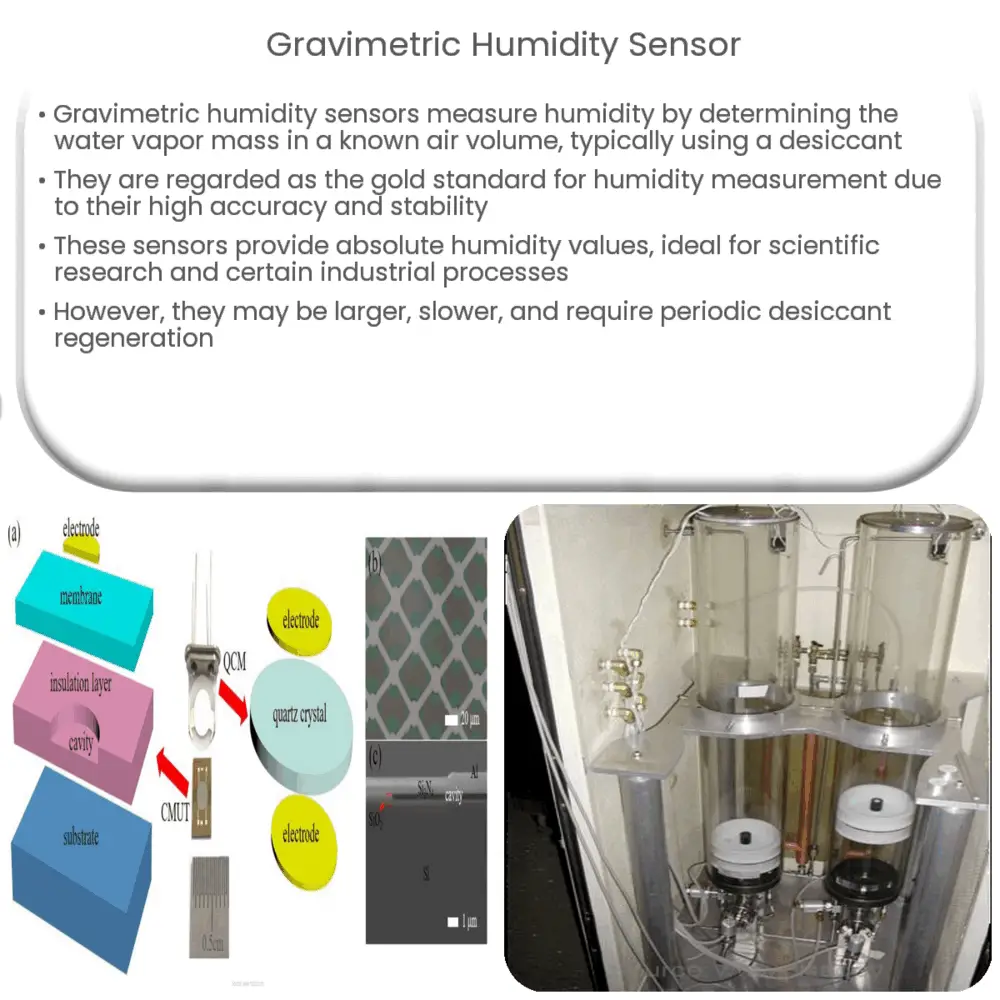A gravimetric humidity sensor measures humidity by calculating the mass of water vapor in a known volume of air, providing accurate and stable readings.

Gravimetric Humidity Sensor: An Introduction
Understanding Humidity and Its Measurement
Humidity is a critical parameter in various applications, including meteorology, agriculture, industrial processes, and even personal comfort. It refers to the amount of water vapor present in the air, which can directly impact the environment, as well as the functionality of equipment and devices. Accurate measurement of humidity is essential in maintaining ideal conditions and ensuring safety and efficiency in various industries.
There are several types of humidity sensors, such as capacitive, resistive, and optical, each with their own advantages and limitations. However, one of the most accurate and reliable methods for measuring humidity is gravimetric sensing.
Gravimetric Humidity Sensor: The Basics
A gravimetric humidity sensor is a type of device that measures humidity by determining the mass of water vapor present in a known volume of air. This measurement is typically achieved by passing a sample of air through a desiccant, which absorbs the water vapor, and then measuring the change in mass of the desiccant. The mass difference can then be used to calculate the absolute humidity of the air sample.
Gravimetric sensing is considered the gold standard for humidity measurement, as it is directly related to the physical property of the air (mass of water vapor) and is, therefore, less susceptible to errors or drifts caused by variations in temperature or pressure. Additionally, gravimetric sensors provide absolute humidity measurements, which are useful in scientific and industrial applications where precise and reliable data is required.
Components of a Gravimetric Humidity Sensor
A typical gravimetric humidity sensor consists of the following components:
- Sampling System: This part of the sensor collects and transports the air sample to the desiccant chamber. The sampling system can include pumps or fans to ensure a consistent flow of air, as well as filters to remove particles and contaminants that might interfere with the measurement.
- Desiccant Chamber: The desiccant chamber contains a moisture-absorbing material, such as silica gel or a molecular sieve, that captures the water vapor from the air sample. The desiccant must be periodically regenerated (dried) to maintain its effectiveness.
- Balance System: The balance system measures the change in mass of the desiccant due to the absorption of water vapor. This can be achieved using a variety of methods, including mechanical balances or electronic weighing devices, which must be highly sensitive and accurate to ensure reliable measurements.
Advantages of Gravimetric Humidity Sensors
Gravimetric humidity sensors offer several advantages over other types of sensors:
- Accuracy: Gravimetric sensors are known for their high accuracy, as they directly measure the mass of water vapor in the air. This makes them suitable for use as reference standards in calibration labs and for scientific research.
- Stability: These sensors are less susceptible to drift and changes in performance due to temperature or pressure variations, which can be an issue with other types of sensors.
- Absolute Measurement: Gravimetric sensors provide absolute humidity values, which can be useful in applications that require precise control of environmental conditions or in the analysis of complex processes.
Limitations and Challenges
Despite their advantages, gravimetric humidity sensors also have some limitations and challenges:
- Size and Complexity: Gravimetric sensors tend to be larger and more complex than other types of humidity sensors, which can limit their use in certain applications or environments.
- Slow Response Time: The time required for the desiccant to absorb the water vapor and the balance system to measure the change in mass can be relatively slow, making these sensors less suitable for applications that require rapid measurements or continuous monitoring.
- Maintenance and Regeneration: The desiccant material must be periodically regenerated to maintain its effectiveness, which can add complexity and cost to the operation of the sensor.
Applications of Gravimetric Humidity Sensors
Due to their high accuracy and stability, gravimetric humidity sensors are well-suited for a variety of applications, including:
- Calibration and Standards: These sensors are commonly used as reference standards for the calibration of other humidity sensors and instruments.
- Scientific Research: Researchers in fields such as meteorology, climatology, and environmental science use gravimetric sensors to obtain accurate and reliable humidity data.
- Industrial Processes: Gravimetric sensors can be used in industries that require precise control of humidity, such as pharmaceutical manufacturing, electronics production, and food processing.
Conclusion
Gravimetric humidity sensors provide highly accurate and stable measurements of humidity, making them an ideal choice for a variety of applications where precision and reliability are paramount. Although they may have some limitations in terms of size, response time, and maintenance requirements, their benefits often outweigh these challenges, especially in scientific research and industrial processes that demand accurate and consistent humidity control.

